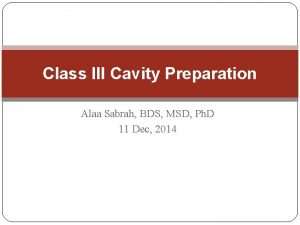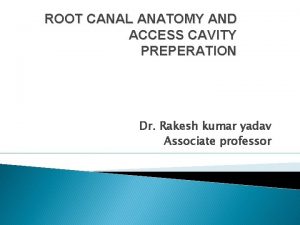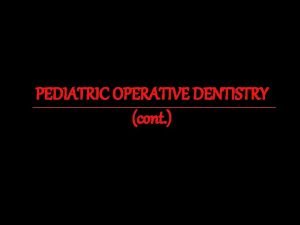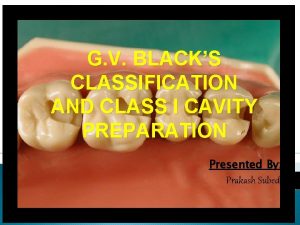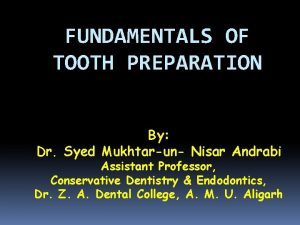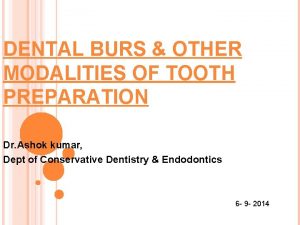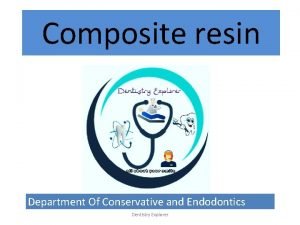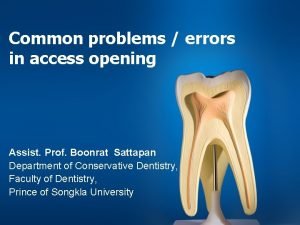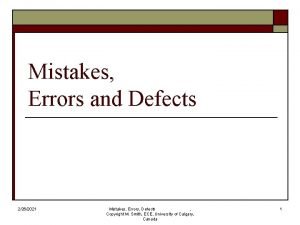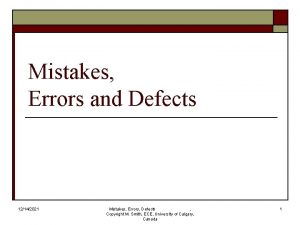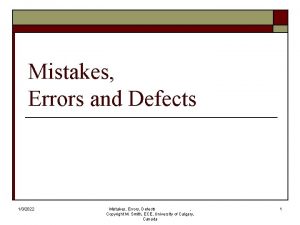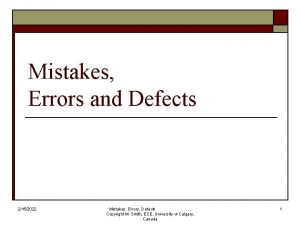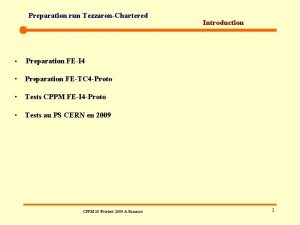Mistakes done during cavity preparation and during cavity


















- Slides: 18

Mistakes done during cavity preparation and during cavity filling

• The basis of preparation of dental hard tissues is the removal of carious tooth tissue and ensure the retention of restorations with regard to the prevention of dental caries. • Leaving carious material on cavity walls and pulpal wall is the cause of secondary or recurrent caries and their consequences.

• During the treatment of tooth decay we need to watch out to maintain healthy dental pulp. • The correct choice of preparation tools and usage of appropriate filling materials are essential in prevention of pain during and after preparation.

Trauma during preparation: • Usage of hand tools is conected with sense of pressure. At low speed are painful sensations equally divided between the pressure, temperature and vibration.

• At high speed pain perception decreases to pressure and vibration, but increases thermal stimulation. Having a insufficient cooling of a prepared tooth surface may damage odontoblasts or irreversibly change the pulp.

• • • Abusive preparation leads to roughening the edges of the enamel and can influence: quality of the filling, bonding strength of filling material with cavity wall , quality of marginal seal Sizing trauma of dental pulp will result in: • cellular changes • hemorrhagias, which can lead to inflammation and necrosis of the pulp.

• Painful sensations arise as a result of vibration of rotating tools that are not well centered, or they are used for a long time. • Pain is increased in patients with damaged periodontal tissue

• In terms of dental caries, most important is lege artis treatment of caries. • Cavity preparation is based on the location of • • • tooth decay, range of loss of dental hard tissues and also depends on the used filling material. Complications can occur: by incomplete removal of carious dentin or in too radical removal of carious material, which may result in perforation of the pulp cavity.

Rule of preventive extension: • Violation of this rule during preparation of the cavity in places habitually unclean, the amount of microbial plaque increases and caries formation occurs.

• New composite materials, in a way binding on hard dental tissues (mechanical, chemical) allow to reduce preparation procedures and conserve hard dental tissues --- preventive fillings By violation of filling retention rule can reflect in: • releasing the filling • or inability of application into the cavity

• Fillings are loaded with mastication presure, • • • therefore the type of material used determines the need for sufficient depth preparation to ensure resistance in filling: Shallow cavities- do not provide sufficient material strength and the bite can break the filling High filling can be damaged during adjusting occlusion and articulation Broken fillings can irritate the marginal periodontium (acute papillitis, a paro. abscess)

• • • For the depth of preparated cavity are valid: Principles of resistance in fillings Important is the range of carious mass Size of the pulp cavity (patient's age, the anatomy of the teeth) Danger of perforation requires gentle preparation and finishing with hand tools. The important thing is to ensure sufficient resistance of the filling against the mastication pressure, and also the remaining dental hard tissues (cusps rule) Pichler

• In the prevention of sec. caries, in amalgam fillings is important that the edge of cavity will be formed by enamel founded by dentin • When using composites main aim is to ensure mechanical retention of the fillíng • Insufficient slope of enamel will be reflected in insuficient marginal seal and may lead to secondary caries

Preventive aspects during cavity fill • The formation of sec. caries or insuficient quality of filling may also be the result of incorect work procedure • most common mistake in amalgame fillings is the wrong choice of the band, the lack of attachment mainly in II. class cavities (injury of dento-gingival attachment, gingivitis) • wet working field

• Damage to the marginal gingiva can also occure in wrong choice of interdental wedge • If the band is poorly sealed, condensing amalgam extrude ower the cavity edge into the interdental space and the removal of it can be harmfull to marginal gingiva • Lack of condensation strength leads to unhomogenic filling

• The presence of gaps between the filling and the dental tissues requires renewal of the filling • In composite materials we need to consider the polymerization shrinkage, determining the suitability of use of different forms of composites

Preventive aspects in finishing of fillings • Poorly adjusted height of filling can cause • • • breakage and drop-out of filling High fillings can also cause acute or chronic damage of periodontal tissue of the tooth In prevention of sec. caries is important the final polishing of the surface and edges of fillings Polished surface also ensures minor storage of microbial film

Thank you for your attention.
 Body cavities labeled
Body cavities labeled Is done was done passive 1
Is done was done passive 1 Cutter mill
Cutter mill Aldanma cahilin kuru lafına
Aldanma cahilin kuru lafına Inlay definition sturdevant
Inlay definition sturdevant Beveled conventional class 3
Beveled conventional class 3 Vertebral cavity
Vertebral cavity Nine regions of the abdominopelvic cavity
Nine regions of the abdominopelvic cavity Peritoneal cavity vs abdominal cavity
Peritoneal cavity vs abdominal cavity Parietal peritoneum visceral peritoneum
Parietal peritoneum visceral peritoneum Cementodentinal junction
Cementodentinal junction Isthmus of tooth preparation
Isthmus of tooth preparation Cavosurface margin
Cavosurface margin Tooth preparation terminology
Tooth preparation terminology 245 bur uses
245 bur uses Conventional tooth preparation
Conventional tooth preparation Axial wall depth in class 2 amalgam
Axial wall depth in class 2 amalgam Maxillry
Maxillry Forward and backward caries
Forward and backward caries





